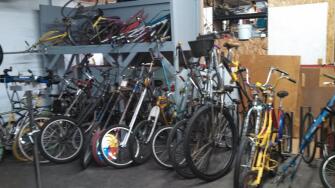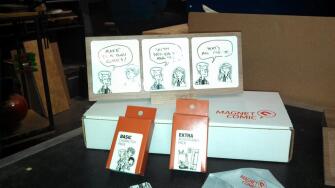“If you had a choice between spending tens of thousands of dollars on a graduate degree in a school of engineering, or spending $250 a month renting a cubicle at the Artisan’s Asylum, I would recommend that you choose the cubicle 100 times over. It’s not even close. I mean, I guess it’s a little rude to say that here at an engineering school that costs tens of thousands of dollars, but I think the experience at the Asylum is much, much more valuable.”
And thus did my dear friend Brandon Stafford begin his remarks to my students in the teacher education program at MIT. Brandon runs a small business, RascalMicro (the computer that powers my in-progress programmable dollhouse), from a cubicle in the Artisan’s Asylum, a 40,000 square foot warehouse that is the largest makerspace in the world.

Imagine about 150 cubicles in close proximity to one another, with waist high walls that let everyone see everyone else. Occupying those 150 cubicles are entreprenuers, artists, and hobbiests engaged in complex, imaginative endeavors. Their shared fees also support a classroom, a social space, a woodshop, a metalworking shop, and a small chemistry lab.

There is a biker gang that builds and rides tricked out bicycles. There is the first leg of what will be a six-legged robot large enough to transport two people. There is a shop making three-panel whiteboards, with magnets and whiteboard markers suitable for making cartoons.

There is, at any given time, learning flowing through thriving networks. Nearly 50 classes are offered every month or so, and these are only the tip of the iceberg. The Asylum is a social space. Don’t know how to use the 3-D frosting printer that uses CAD files to decorate a cake? Just ask. The point of the community isn’t just to use the metalworking shop; it’s to make sure that everyone can use all of the tools in the metalworking shop.

How, as a society do we measure and quantify these makers? One young man in the Asylum, who seems not to have necessarily found the most success in the K-12 schooling system, has built his own electric motorcycle. Full-sized. Silent. Green. Awesome. He writes in his blog,“Riding a silent electric motorcycle is the closest I have come to flying while not dreaming.”
Assuredly, he knows more about engineering than only a tiny, tiny fraction of people applying for college. He’s applying for a bachelors program in one of our local state colleges and he’s also applying for a masters degree program from the MIT Media Lab, which has no requirements for degree or GREs and is headed by a man without a college diploma. He’ll either attend one of the weaker colleges in our state system, or one of the best design and engineering programs in the world. Colleges all over the world recruit and vie for the attention of people who score really highly on the PSAT. How do we get them to pay attention to kids who can build their own street legal transportation?
The New York Times has an article today on Sylvia Todd, an 11 year old girl who is the star of Sylvia’s Super-Awesome Maker Show, where she demonstrates how to make circuits, copper pendants, conductive play dough, and other DIY projects. What do other kids make of Sylvia: “Sylvia says most of her classmates either don’t know or don’t care about her show. ‘They think it’s boring,’ she said. ‘They think of me as Sylvia; they don’t know the Super-Awesome Sylvia.’
We don’t know the super-awesome Sylvia. We don’t know her maker colleagues. They aren’t on the radar. My 25 students from MIT live 10 minutes from the largest maker space in the world, and none had ever visited and few had heard of it. Colleges don’t know how to recruit kids who build their own motorcycles. We don’t know how to count learning that can’t fit into our course hours and Carnegie units.
If you speak with them, you will hear the passion of the converted, of people who have found a purpose, a community, and home. But most people don’t know what to make of the makers.
Understanding the makers isn’t actually that expensive. Sylvia’s father says they spend maybe $100 a year on components for projects. What it costs to understand the makers, is time. Time to tinker. Time to visit their communities. Time to evaluate their idiosyncratic learning.
In a world where we need fewer people to conduct routine tasks, fewer people to be cogs in the industrial machine, we will need to find more ways to empower young people to chart their own path, to invent their own jobs, to find their own ways to contribute. Young people today won’t have a future to walk into. They’ll need to make it.
For regular updates, follow me on Twitter at @bjfr and for my publications, C.V., and online portfolio, visit EdTechResearcher.
